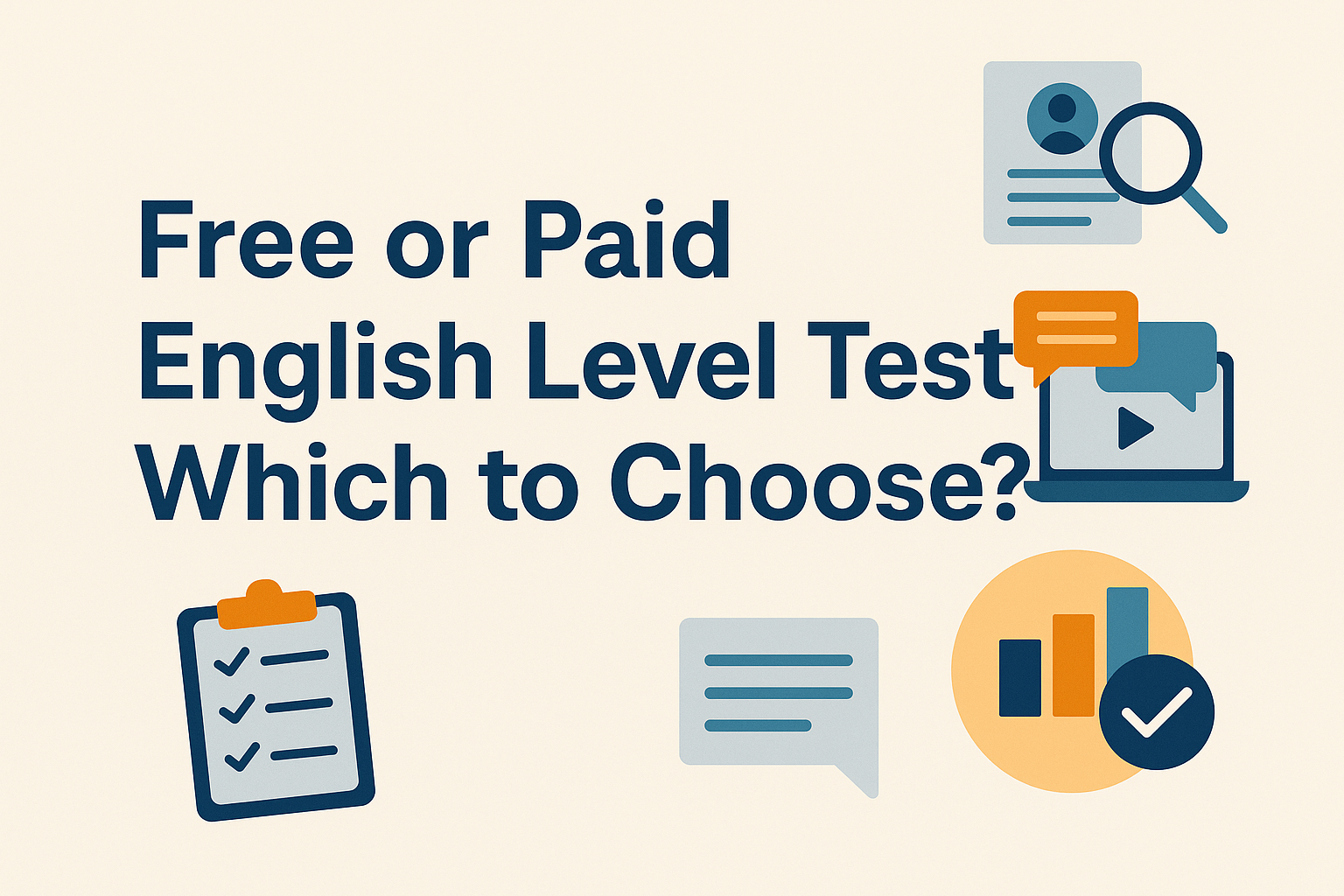When should you choose a free English level test? And when is a paid test the best option? Find out more in this article.
English placement tests are essential tools for evaluating the language level of students, job applicants, or new employees.
However, with numerous options available, a common question arises: Should you use a free English test or invest in a paid solution?
The answer depends on your goals, the profile of the test takers, and—most importantly—how accurate and reliable you need the results to be.
In this article, we’ll compare the pros and cons of free versus paid English tests, share key selection criteria, and demonstrate how automated solutions like FluencyFlow are transforming the way fluency is measured—with increased speed, fairness, and reliable data.
What Is an English Placement Test?
An English placement test is a diagnostic tool used to determine a person’s actual language proficiency.
It helps identify whether the learner:
- Has mastered basic structures,
- Can communicate fluently,
- Or requires support in specific skills, such as listening, speaking, reading, or writing.
Placement tests help:
- Align expectations,
- Strategically plan teaching methods,
- And ensure each student is placed at the right point in their learning journey.
In other words, a placement test prevents both underplacement (putting someone on a level that’s too easy) and overplacement (placing them on a level that’s too advanced).
Depending on the context, these tests can be used to:
- Place new students in the right class or course level;
- Restructure groups based on speaking and comprehension performance;
- Track progress over time;
- Support hiring decisions for English-required roles;
- Customize adaptive learning paths.
But not all tests are created equal. A good English test should be:
- Pedagogically sound,
- Aligned with the learner’s real-world communication needs,
- And designed to measure meaningful skills—especially speaking fluency.
This is where the decision between a free test and a professional solution becomes critical.
When Free English Tests Can Work
There are many free English tests online—often short, multiple-choice quizzes that focus on vocabulary and grammar.
They can be helpful for:
- Giving a rough idea of someone’s level;
- Engaging beginners in their early stages of learning;
- Establishing a baseline before undertaking a more comprehensive diagnostic process.
However, they have apparent limitations:
- Lack of depth – usually no speaking, listening, or writing assessment;
- Low reliability – no control over timing, identity, or environment;
- Inaccurate results – most don’t follow CEFR or international frameworks;
- No actionable reports – results don’t support informed decisions.
In short, free tests may work in informal settings—but they’re not reliable for profound teaching, selection, or institutional use.
When Paid English Tests Are Worth the Investment
Paid tests typically offer a more structured, reliable, and scalable process.
They’re ideal when the goal is to get fair, standardized, and actionable results.
Advantages of paid solutions:
- Trained evaluators or AI ensure accurate analysis;
- Complete coverage of the four skills: reading, writing, listening, and speaking;
- Detailed reports with pedagogical recommendations;
- Alignment with standards like CEFR;
- Scalable administration for schools or companies.
Modern tools like FluencyFlow go even further, using AI to evaluate spoken English, analyzing:
- Clarity,
- Natural speech flow,
- Vocabulary usage,
- And response timing.
This level of analysis would be impossible to scale manually—but it’s made feasible and consistent through technology.
When to Use Each Type of Test
To decide between a free or paid test, consider:
- Purpose
- Is the goal to spark initial interest or truly understand someone’s fluency?
- Impact of the result
- Will the result determine class placement, hiring, or certification?
- Scale and frequency
- Will this test be used regularly and across many learners?
- Budget
- Cost matters—but paid solutions often save time, reduce misplacements, and avoid rework.
FluencyFlow: Beyond Traditional English Testing
Among the most innovative paid tools, FluencyFlow stands out by combining advanced technology with sound pedagogy.
It’s not just another English test—it’s an intelligent speaking assessment platform.
Designed for schools, institutions, and companies, FluencyFlow delivers objective, scalable, and fair fluency evaluations.
Rather than focusing on grammar or multiple-choice formats, it captures real spoken responses to contextual questions.
The AI system evaluates:
- Response time and spontaneity,
- Idea clarity and coherence,
- Speech rhythm and naturalness,
- Vocabulary variety,
- Pronunciation and intonation (without penalizing accents).
This makes the process fair and practical—measuring what matters: the ability to communicate clearly and confidently.
FluencyFlow also offers:
- Detailed, actionable reports for teachers and coordinators;
- Scalable administration for hundreds or thousands of students;
- Reliable data to guide instructional decisions and reduce guesswork.
It’s no surprise that more institutions are turning to this approach—moving from subjective evaluations to standardized, meaningful assessments.
Conclusion: Which English Test Is Best for You?
If you need a general sense of a learner’s level—for informal purposes—free tests can be a good starting point.
But if decisions depend on reliable data—for placement, progress tracking, or hiring—then investing in a professional tool is essential.
Ultimately, it’s not just about choosing between free and paid options.
It’s about choosing between guessing someone’s level and truly knowing it.
For schools, networks, and companies looking to assess English fluency with precision and fairness, tools like FluencyFlow are setting a new standard.
Because accurate assessment is the first step toward better teaching, placement, and outcomes.




